Dodge Journey: Manifold, exhaust, front
Removal
1. Disconnect negative battery cable.
2. Remove the engine cover.
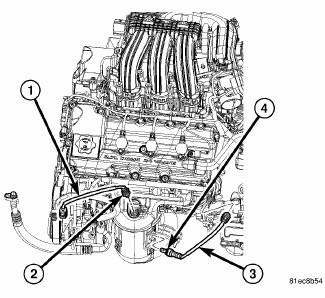
Fig. 295: Oxygen Sensors
3. Disconnect and remove oxygen sensors (2) and (4).
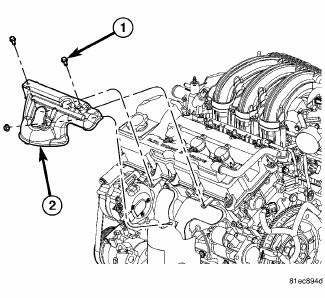
Fig. 296: Upper Maniverter Heat Shield
4. Remove the upper maniverter heat shield (2).
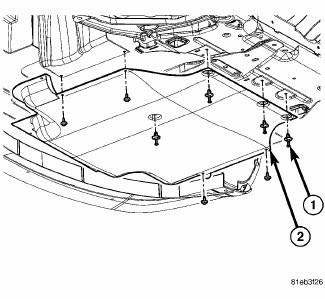
Fig. 297: Belly Pan
- - belly pan fasteners
- - belly pan
5. Remove the belly pan (2).
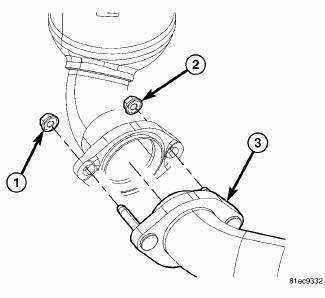
Fig. 298: Front Maniverter-To-Cross Under Fasteners
6. Remove the front maniverter-to-crossunder fasteners (1) and (2).
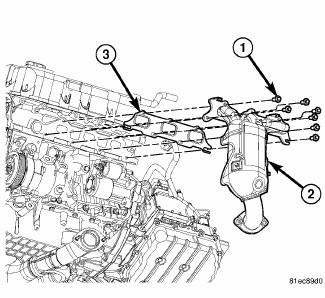
Fig. 299: Front Exhaust Maniverter Attaching Bolts
7. Remove front exhaust maniverter attaching bolts (1) and remove the front maniverter (2).
Inspection
1. Inspect exhaust manifolds for damage or cracks.
2. Check manifold flatness.
3. Inspect the exhaust manifold gasket for obvious discoloration or distortion.
4. Check distortion of the cylinder head mounting surface with a straightedge and thickness gauge.
Installation
1. Clean gasket mounting surfaces.
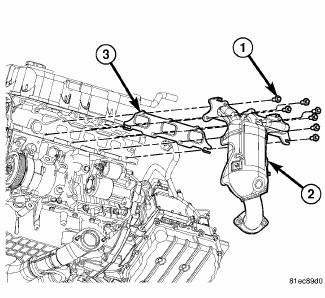
Fig. 300: Front Exhaust Maniverter Attaching Bolts
2. Install a new gasket (3), the front maniverter (2), and the front exhaust maniverter attaching bolts (1).
Tighten bolts to 23 Nm (17 ft. lb).
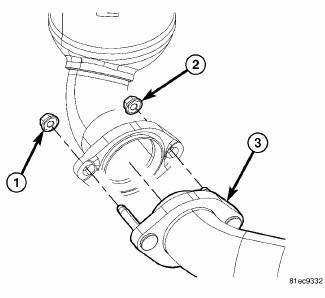
Fig. 301: Front Maniverter-To-Cross Under Fasteners
3. Install the front maniverter-to-crossunder fasteners (1) and (2). Tighten to 27 Nm (20 ft. lb.).
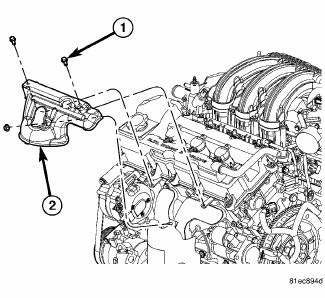
Fig. 302: Upper Maniverter Heat Shield
4. Install the upper maniverter heat shield (3) and the heat shield fasteners (1) and (2). Tighten fasteners to 12 Nm (106 in. lb.).

Fig. 303: Oxygen Sensors
5. Install the oxygen sensors (2) and (4). 41 Nm (30 ft. lbs.)

Fig. 304: Belly Pan
- - belly pan fasteners
- - belly pan
6. Install the belly pan (2).
7. Install the negative battery cable.
8. Install the engine cover.
 Manifold, exhaust, crossover
Manifold, exhaust, crossover
Removal
Fig. 287: Belly Pan
- belly pan fasteners
- belly pan
1. Remove the belly pan (2).
Fig. 288: Exhaust Extension Pipe
2. Remove the fasteners (1), and remove the exhaust extensio ...
 Manifold, exhaust, rear
Manifold, exhaust, rear
Removal
Fig. 305: Belly Pan
- belly pan fasteners
- belly pan
1. Remove the belly pan (2).
Fig. 306: Oxygen Sensors
2. Remove the oxygen sensors (2) and (4).
Fig. 307: Exhaust Gas R ...
See also:
Hub and bearing
DESCRIPTION
Fig. 31: Front Hub And Bearing Mounting
The front wheel bearing and wheel hub of this vehicle are a one piece sealed
unit or hub and bearing unit type
assembly.
The hub and beari ...
Rod, piston and connecting
Description
Fig. 206: Piston & Connecting Rod
- "F" TOWARD FRONT OF ENGINE
- RING COMPRESSOR
- SPECIAL TOOL 8189
- OIL SQUIRT HOLE
The pistons (1) are made of a high stre ...
MOPAR PARTS
MOPAR fluids, lubricants, parts, and accessories are
available from an authorized dealer. They are recommended
for your vehicle in order to help keep the vehicle
operating at its best. ...
